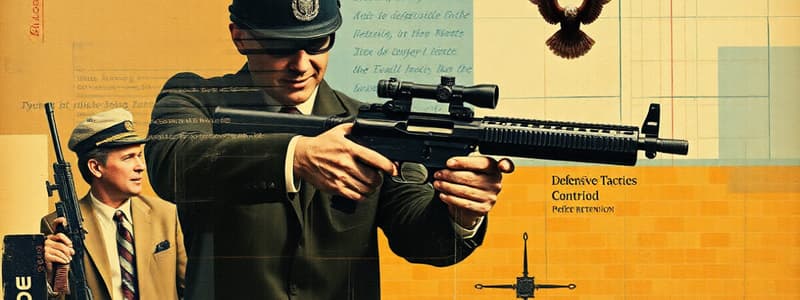Podcast
Questions and Answers
In the Monadnock Defensive Tactics System, which principle serves as the initial focus?
In the Monadnock Defensive Tactics System, which principle serves as the initial focus?
- Control & Takedown
- Block & Strike
- Escort & Drag
- Protect & Restrain (correct)
- None of the above
What is the ideal distance to maintain during an interview scenario, as recommended by MDTS programs?
What is the ideal distance to maintain during an interview scenario, as recommended by MDTS programs?
- 3 to 4 feet
- 4 to 6 feet
- 4 to 5 feet
- 3 to 5 feet (correct)
- 5 to 6 feet
When employing holstered weapon retention techniques, which action should be prioritized FIRST?
When employing holstered weapon retention techniques, which action should be prioritized FIRST?
- Secure the weapon in the holster
- Effect a release
- Position the body (correct)
- Create distance
- None of the above
Within the MDTS framework, which of the following is considered the basis or the most fundamental element?
Within the MDTS framework, which of the following is considered the basis or the most fundamental element?
What blocking technique in MDTS utilizes both arms to defend against a direct, forceful attack?
What blocking technique in MDTS utilizes both arms to defend against a direct, forceful attack?
Flashcards
Reactionary Gap
Reactionary Gap
The gap maintained between an officer and a subject to ensure safety and reaction time.
Control
Control
A defensive principle emphasizing controlling a subject's movements to prevent escalation.
High Block
High Block
Using both arms to create a barrier against a frontal attack .
Elbow Shielding
Elbow Shielding
Signup and view all the flashcards
MDTS interview gap
MDTS interview gap
Signup and view all the flashcards
Study Notes
- The document is a written test for the MDTS (Monadnock Defensive Tactics System) Basic Course.
- The test includes a matching section where candidates identify body areas on diagrams and multiple-choice questions about MDTS principles.
Multiple Choice Questions Overview
- The multiple-choice section covers the philosophy of MDTS, interview gap recommendations, weapon retention rules, foundational elements of MDTS, personal weapons, blocking skills, and weapon shielding methods.
Key Concepts from Multiple Choice Questions
- The MDTS philosophy is best characterized as protection and restraint.
- The recommended interview gap in MDTS programs is 3 to 4 feet.
- The first rule in holstered weapon retention is to position the body.
- The reactionary gap is the foundation of MDTS.
- The forehead is not considered a personal weapon in the MDTS Basic Course.
- The high block relies on both arms to stop a frontal attack.
- Other methods of shielding a service weapon according to MDTS are cross body and near body.
Studying That Suits You
Use AI to generate personalized quizzes and flashcards to suit your learning preferences.

